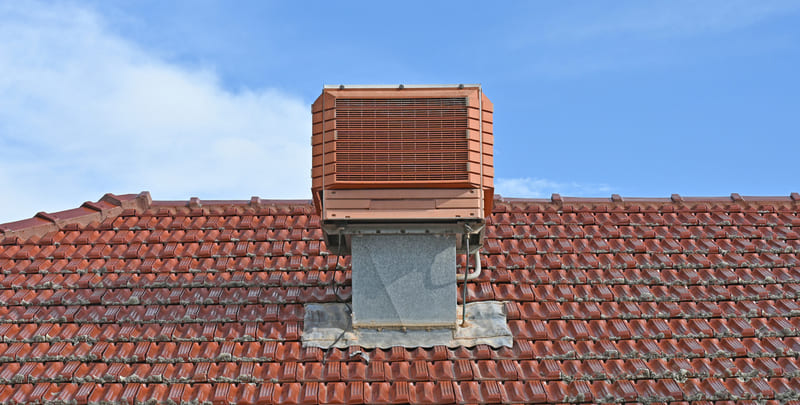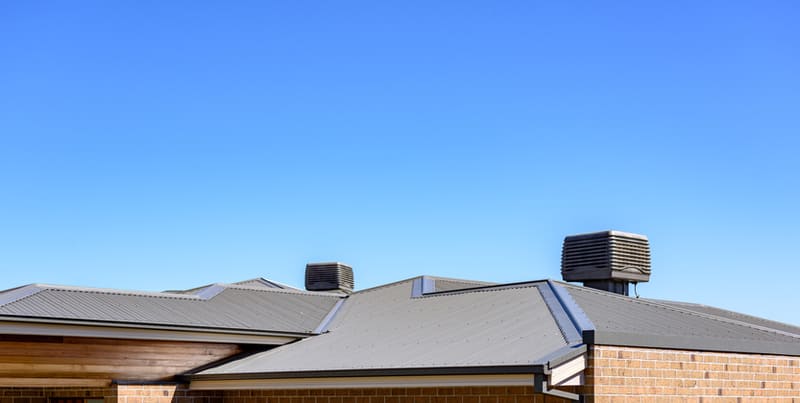Evaporative cooling is a natural and energy-efficient technique for cooling indoor spaces, leveraging the cooling effect of water evaporation. It provides a sustainable and cost-effective alternative to traditional air conditioning systems.
An appropriate cooling system optimises comfort and efficiency, impacting energy consumption, environmental considerations, and overall performance. Therefore, understanding the pros and cons of evaporative cooling is essential for making informed decisions tailored to specific needs.
How Evaporative Coolers Work
An evaporative cooler work on the principle of water evaporation. Also known as swamp coolers, they use wet filter pads to absorb water vapour. When outside air passes through these pads, the water evaporates, absorbing heat.
This process cools the air, which is then circulated indoors, providing a cooler environment. It provides a natural and refreshing indoor environment with precise temperature control.
Environmental Impact of Evaporative Coolers
Compared to traditional ducted air conditioning systems, evaporative cooling has a minimal ecological footprint. It avoids harmful refrigerant gas products and consumes less electricity, aligning with the trend towards eco-conscious living. The system’s environmental friendliness contributes to sustainable and greener cooling solutions.
Pros of Evaporative Cooling
This eco-friendly and energy-efficient cooling method stands out in several key areas, making it an appealing choice over most traditional air conditioners for those seeking optimal comfort without compromising sustainability.
1. Energy Efficiency
Evaporative cooling systems are renowned for their remarkable energy efficiency in creating the ideal indoor air temperature. Unlike traditional air conditioning units that heavily absorb heat and rely on electricity-intensive compressors and refrigerants, evaporative coolers primarily utilise fan and water pump energy. This results in significantly less energy consumption, reducing end-users electricity bills.
2. Cost-Effectiveness
From an economic standpoint, the cost-effectiveness of evaporative cooling is a compelling factor. The initial investment in purchasing and installing an evaporative cooling system is generally lower than traditional air conditioning. Moreover, operational costs, including higher electricity bills and maintenance, are often more budget-friendly, providing long-term financial advantages.
3. Eco-Friendly Operation
In an era where environmental consciousness is paramount, evaporative cooling shines as an eco-friendly option. Unlike conventional refrigerated air conditioning systems that use refrigerants with potential ecological impacts, evaporative coolers operate without such refrigerant gases or harmful substances.
It aligns with the growing trend towards sustainability and contributes to a greener and more environmentally conscious living or working space.
4. Health Benefits
One often overlooked aspect of the cooling power of evaporative cooling is its positive impact on indoor air quality and human health. The natural cooling process involves adding moisture to the warm air from the outside, which is especially beneficial in dry climates. This additional moisture from fresh air helps alleviate respiratory discomfort associated with dry air, promoting a healthier and more comfortable indoor environment.
5. Air Quality Improvement
Evaporative systems actively filter and humidify the air during operation. This dual functionality reduces airborne particles and allergens, contributing to a significant improvement in indoor air quality. This feature makes evaporative cooling a desirable and health-conscious choice for individuals with respiratory conditions or allergies.

Cons of Evaporative Cooling
However, an evaporative cooler has its limitations. It is most effective in dry climates, and its efficiency decreases in humid conditions. Regularly maintaining evaporative coolers is essential to ensure optimal performance outside the temperature above, and there may be concerns about water usage in regions facing scarcity. Installation challenges, particularly in retrofitting evaporative coolers existing structures, can also be a drawback.
1. Climate Dependence
Wet climates and high humidity levels, characterised by summer heat and elevated moisture levels, notably diminish the efficacy of evaporative cooling. The system’s reliance on the evaporation process, which thrives in dry and fresh air, makes it less effective to cool air even in humid climates. In such environments, the cooling efficiency decreases, limiting its practicality and prompting consideration of alternative cooling solutions that better adapt to varying climate conditions.
2. Maintenance Requirements
While evaporative cooling systems are generally known for their low-maintenance reputation, maintaining optimal performance necessitates consistent attention. Filters and filter pads, integral components of the system, demand periodic cleaning or replacement to prevent the accumulation of dirt and dust particles and ensure the system operates efficiently.
The water distribution system also requires regular maintenance to prevent potential clogs, preserving a consistent and reliable cooling performance.
3. The Need for a Separate Heating System
As its name suggests, portable evaporative coolers or even a ducted evaporative cooler for the entire home, only provides cooling functions. That’s all well and good for the warmer summer months. But what about when the mercury drops and it’s time to bring some warmth into your home? In that case, you’ll need a separate heating system for the winter. Reverse cycle air conditioners cover all your cooling AND heating needs for the year, bringing the required chill to the hot air in summer, and heating up the home throughout the winter months.
4. Water Usage Concerns
The operation of evaporative coolers relies on water consumption as a fundamental component of the cooling process. While technological advancements aim to minimise water usage, concerns may arise, especially in water scarcity areas. Expert assessment and consultation become crucial to balance achieving effective cooling and practising responsible water usage, particularly in regions where water conservation is a priority.
5. Installation Challenges
Installing evaporative cooling refrigerated systems presents challenges, especially when retrofitting existing structures. Proper sizing, strategic ductwork installation, and precise unit positioning influence the system’s effectiveness.
Expertise in assessing the unique requirements of refrigerated cooling systems in a given space is necessary to ensure optimal performance, prevent potential issues stemming from improper installation, and guarantee that the cooling system seamlessly integrates with the existing infrastructure.
Factors to Consider When Choosing an Evaporative Cooler
When deciding on evaporative cooling over an alternative like reverse cycle air conditioning, one must consider several factors. These typically include:
- Climate conditions
- Space requirements
- A commitment to regular maintenance
- The need for a constant supply of water
- Higher running costs
- Separate heating systems and
- Initial installation costs
Proper sizing, installation, and adherence to maintenance schedules are crucial to maximising the system’s efficiency.
Choosing an evaporative cooler involves considering various factors to ensure optimal performance and alignment with specific needs. Below are vital factors to contemplate when choosing the right cooling system for your home.
1. Climate Considerations
Evaluate the local climate to determine the suitability of evaporative cooling. This method of climate control is most effective in dry climates with low humidity levels. Assessing the prevailing weather conditions ensures that the system can operate efficiently, providing adequate cooling without being hindered by high humidity in the air.
2. Size and Layout of the Space
Consider the size and layout of the area intended for cooling. Proper sizing only the fan and evaporative cooler is crucial for efficient performance. A unit with ducted air conditioning that is too small may struggle to move cool air throughout the space, while an oversized unit could lead to unnecessary energy consumption. Evaluate the layout of the outdoor unit to ensure even distribution of cooled air conditioner and warm air throughout the designated space.
3. Maintenance Commitment
Assess your willingness to commit to regular maintenance tasks. While evaporative coolers are generally low-maintenance compared to most air conditioners or traditional air conditioning systems, adherence to cleaning schedules for filters and pads is essential. Regular maintenance ensures your evaporative cooler works at optimal performance and prolongs the life of the cooling system.
4. Water Availability
Ensure a constant, stable, and sufficient water supply for the system. Evaluate the water availability in the area, especially in regions where water scarcity is a concern. Consider whether you can connect the water source to a municipal supply or if you need a dedicated reservoir. Understanding water availability is critical for the continuous operation of the evaporative cooling system.
5. Placement and Sizing
Proper placement and sizing of the evaporative cooler are critical for efficient cooling. Position the indoor unit strategically to ensure even distribution of cooled air throughout the designated space. Sizing considerations should align indoor units with AC systems’ other cooling capacity needs, preventing underperformance or unnecessary energy consumption.

How Professional Installation Can Help
Professionals play a crucial role in assisting individuals in selecting suitable evaporative coolers for their specific needs. They consider factors such as the size of the space to be cooled and climate conditions to recommend the most suitable evaporative cooler.
In addition to technical knowledge, professionals often have hands-on experience with different brands and models. This practical familiarity enables them to provide insights into various evaporative coolers’ reliability, durability, and maintenance requirements. Clients benefit from this first-hand information, gaining confidence in their choice and ensuring long-term satisfaction with their cooling investment.
- Assessment: They conduct a thorough evaluation of your space, considering factors like size, layout, and climate to determine the most suitable evaporative cooler for your needs.
- Installation guidance: They advise on proper installation, ensuring optimal performance and efficiency of the evaporative cooler.
- Maintenance tips: Professionals offer valuable insights on maintenance practices, helping you prolong the lifespan of the cooler and prevent potential issues.
- Customisation: Tailoring their recommendations to your requirements, professionals ensure the selected evaporative cooler aligns with your preferences and lifestyle.
- Energy efficiency: By considering energy-efficient models, professional service providers assist you in making environmentally friendly choices that save on operational costs.
With a deep understanding of evaporative cooling, the various models and their features, professionals can guide customers through the decision-making process.
With the Pros and Cons of Evaporative Cooling in Mind …
This guide to the pros and cons of evaporative cooling emphasises the low energy consumption, efficiency and eco-friendly nature of evaporative cooling. Yes, it has its limitations, including climate dependence and maintenance requirements.
However, the numerous benefits make it a viable and attractive option for those seeking an efficient and environmentally friendly cooling alternative to traditional air conditioners.
Encouraging a thoughtful decision-making process, the guide reinforces the importance of considering specific factors to determine whether an evaporative cooler aligns with the unique requirements of a given environment.
Please note: This information is provided for advice purposes only. Regulations differ from state to state, so please consult your local authorities or an industry professional before proceeding with any work. See our Terms & Conditions here.

